Divine Comedy + Decameron discussion

This topic is about
The Decameron
Boccaccio's Decameron
>
6/2-6/8 : The Decameron, First Day, Introduction & Stories 1-5
date newest »
newest »
 newest »
newest »
 Illustrations - Day I story 5
Illustrations - Day I story 5
http://visualiseur.bnf.fr/ConsulterEl...
ms 63 - Philippe Auguste & the marquise of Montferrat
More (view spoiler)
 Book Portrait wrote: "Illustrations - Day I story 4
Book Portrait wrote: "Illustrations - Day I story 4http://visualiseur.bnf.fr/ConsulterEl...
ms 63
More
http://digi.vatlib.it/diglitData/imag......."
And that is how you get dirty habits...
(sorry for the pun, couldn't help myself ;) )
All roads seem to lead to the 101/1001 Nights!
A frame story (also frame tale, frame narrative, etc.) is a literary technique that sometimes serves as a companion piece to a story within a story, whereby an introductory or main narrative is presented, at least in part, for the purpose of setting the stage either for a more emphasized second narrative or for a set of shorter stories. The frame story leads readers from a first story into another, smaller one (or several ones) within it.
An early example of the frame story is The Book of One Thousand and One Nights, in which the character Scheherazade narrates a set of fairy tales to the Sultan Shahriyar over many nights. Many of Scheherazade's tales are also frame stories, such as Tale of Sindbad the Seaman and Sindbad the Landsman, a collection of adventures related by Sindbad the Seaman to Sindbad the Landsman.
Frame stories are often organized as a gathering of people in one place for the exchange of stories. Each character tells his or her tale, and the frame tale progresses in that manner. Historically famous frame stories include Chaucer's Canterbury Tales, about a group of pilgrims who tell stories on their journey to Canterbury; and Boccaccio's Decameron about a group of young aristocrats escaping the Black Death to the countryside and spending the time telling stories.
What's in a frame? The Medieval Textualization of Traditional Storytelling
http://journal.oraltradition.org/file...
For those of you who were not in the Proust read and may be surprised at the mention of 101 Nights:
Manuscript Of Mi’a Layla Wa Layla (one Hundred And One Nights) And The Kitab Al-Jughrafiyya (book Of Geography) Of Al-Zuhri (d .1154–1161)
http://www.akdn.org/museum/detail.asp...
'Arabian Nights' has a smaller sibling
http://www.egyptindependent.com/news/...
A frame story (also frame tale, frame narrative, etc.) is a literary technique that sometimes serves as a companion piece to a story within a story, whereby an introductory or main narrative is presented, at least in part, for the purpose of setting the stage either for a more emphasized second narrative or for a set of shorter stories. The frame story leads readers from a first story into another, smaller one (or several ones) within it.
An early example of the frame story is The Book of One Thousand and One Nights, in which the character Scheherazade narrates a set of fairy tales to the Sultan Shahriyar over many nights. Many of Scheherazade's tales are also frame stories, such as Tale of Sindbad the Seaman and Sindbad the Landsman, a collection of adventures related by Sindbad the Seaman to Sindbad the Landsman.
Frame stories are often organized as a gathering of people in one place for the exchange of stories. Each character tells his or her tale, and the frame tale progresses in that manner. Historically famous frame stories include Chaucer's Canterbury Tales, about a group of pilgrims who tell stories on their journey to Canterbury; and Boccaccio's Decameron about a group of young aristocrats escaping the Black Death to the countryside and spending the time telling stories.
What's in a frame? The Medieval Textualization of Traditional Storytelling
http://journal.oraltradition.org/file...
For those of you who were not in the Proust read and may be surprised at the mention of 101 Nights:
Manuscript Of Mi’a Layla Wa Layla (one Hundred And One Nights) And The Kitab Al-Jughrafiyya (book Of Geography) Of Al-Zuhri (d .1154–1161)
http://www.akdn.org/museum/detail.asp...
'Arabian Nights' has a smaller sibling
http://www.egyptindependent.com/news/...
I've been trying to find Fifth Tale (I, 5) origin from the 1001 Nights. BP maybe you can help....
The Marchioness of Montferrat by a banquet of hens seasoned with wit checks the mad passion of the King of France.
Fiammetta tells this story, which originates from The Thousand and One Arabian Nights.
The Marchioness of Montferrat by a banquet of hens seasoned with wit checks the mad passion of the King of France.
Fiammetta tells this story, which originates from The Thousand and One Arabian Nights.
Frame tales: comparison of Decameron and 1001 Nights
Boccaccio’s Decameron is a frame tale with death set outside the frame. In the Decameron, seven women and three men (the brigata) leave plague-stricken Florence for country estates. There they enjoy telling each other stories. The transition from story to story is a matter of civilized, turn-taking within the brigata. In 1001 Nights, Shahrazad tells the King stories to forestall being executed. That’s similar to the Sindibad frame tale in which a king’s advisers tell stories to forestall the king from executing his son on a false rape charge. Other ancient frame tales such as the Panchatantra and the Sukasaptati are not generated against the threat of death. Story-telling creates imaginary lives. The threat of death highlights the creativity of story-telling. In contrast to the 1001 Nights’ frame, the Decameron’s frame doesn’t make the creativity of story-telling directly ward off death. Story-telling in the Decameron shares pleasure in the face of death.
To read more: http://purplemotes.net/2014/04/13/fra...
Boccaccio’s Decameron is a frame tale with death set outside the frame. In the Decameron, seven women and three men (the brigata) leave plague-stricken Florence for country estates. There they enjoy telling each other stories. The transition from story to story is a matter of civilized, turn-taking within the brigata. In 1001 Nights, Shahrazad tells the King stories to forestall being executed. That’s similar to the Sindibad frame tale in which a king’s advisers tell stories to forestall the king from executing his son on a false rape charge. Other ancient frame tales such as the Panchatantra and the Sukasaptati are not generated against the threat of death. Story-telling creates imaginary lives. The threat of death highlights the creativity of story-telling. In contrast to the 1001 Nights’ frame, the Decameron’s frame doesn’t make the creativity of story-telling directly ward off death. Story-telling in the Decameron shares pleasure in the face of death.
To read more: http://purplemotes.net/2014/04/13/fra...
Sorry, this is for the Proustians:
Marcel Proust saw himself as Scheherazade, in relation to both sex and death. At the end of the almost endless novel, "Remembrance of Things Past," he writes a triumphant meditation on the presence of death, which has in fact driven him to create his great and comprehensive book, the book of his life. At one point he even personifies this presence of death as "le sultan Sheriar," who might or might not put a dawn end to his nocturnal writing. Malcolm Bowie, in "Proust Among the Stars," comments that "the big book of death-defying stories" with which Proust's novel compares itself is not Boccaccio's "Decameron," in which death appears as a "horrifying initial trigger to tale-telling," but the "Nights," where stories are life. "Narrate or die," for Proust's narrator as for Scheherazade, is the imperative. "By mere sentences placed end on end, one's sentence is commuted for a while, and the end is postponed."
http://partners.nytimes.com/library/m...
Marcel Proust saw himself as Scheherazade, in relation to both sex and death. At the end of the almost endless novel, "Remembrance of Things Past," he writes a triumphant meditation on the presence of death, which has in fact driven him to create his great and comprehensive book, the book of his life. At one point he even personifies this presence of death as "le sultan Sheriar," who might or might not put a dawn end to his nocturnal writing. Malcolm Bowie, in "Proust Among the Stars," comments that "the big book of death-defying stories" with which Proust's novel compares itself is not Boccaccio's "Decameron," in which death appears as a "horrifying initial trigger to tale-telling," but the "Nights," where stories are life. "Narrate or die," for Proust's narrator as for Scheherazade, is the imperative. "By mere sentences placed end on end, one's sentence is commuted for a while, and the end is postponed."
http://partners.nytimes.com/library/m...
The Influence of the Arabian Nights onEnglish Literature: A Selective Study
http://www.academia.edu/1780309/The_I...
The Arabian images of the Nights were full with magnitude and wonder of Arabian romanceswhich were considered to be part of the medieval European entertainment. Europe also had Arabianlegends in Greek and Roman literatures. In depth, the conventional Arabic style which has a narratorwho says the story of other narrators telling stories, is seen in such works as Dante Alighieri's (1265–1321)
Divine Comedy, Boccaccio’s (1313–1375) Gesta Romanorum and Decameron,and GeoffreyChaucer's (c. 1343–1400)The Canterbury Tales.Modern readers to Chaucer Canterbury Tales (c.1388-1400) can recognize a possible source of the effect of the Arabian Nights’
themes. Forinstance, the motif of the mechanical horse in the Arabian tale, 'The Story of the Enchanted Horse,' ispresent in Chaucer’s
'The Squire's Tale'. Likewise, the frame-story of "The Sleeper Awakened" tellsthe Arabian story of Abu Al-Hasan, a simple Baghdadian merchant, who is deceived to believe that hehimself, at once, becomes in the place of the Abbasid Caliph of Baghdad, Haroun al Rashid.
http://www.academia.edu/1780309/The_I...
The Arabian images of the Nights were full with magnitude and wonder of Arabian romanceswhich were considered to be part of the medieval European entertainment. Europe also had Arabianlegends in Greek and Roman literatures. In depth, the conventional Arabic style which has a narratorwho says the story of other narrators telling stories, is seen in such works as Dante Alighieri's (1265–1321)
Divine Comedy, Boccaccio’s (1313–1375) Gesta Romanorum and Decameron,and GeoffreyChaucer's (c. 1343–1400)The Canterbury Tales.Modern readers to Chaucer Canterbury Tales (c.1388-1400) can recognize a possible source of the effect of the Arabian Nights’
themes. Forinstance, the motif of the mechanical horse in the Arabian tale, 'The Story of the Enchanted Horse,' ispresent in Chaucer’s
'The Squire's Tale'. Likewise, the frame-story of "The Sleeper Awakened" tellsthe Arabian story of Abu Al-Hasan, a simple Baghdadian merchant, who is deceived to believe that hehimself, at once, becomes in the place of the Abbasid Caliph of Baghdad, Haroun al Rashid.
Thank you for these, Reem... plenty to think about.. we may have to read the Arabian Nights sometime.
 I'm happy to being joining this reading group for The Decameron. I started following in the middle of Dante and really enjoyed the posts. I hope I'm able to contribute a little here and there.
I'm happy to being joining this reading group for The Decameron. I started following in the middle of Dante and really enjoyed the posts. I hope I'm able to contribute a little here and there.
Mishek wrote: "I'm happy to being joining this reading group for The Decameron. I started following in the middle of Dante and really enjoyed the posts. I hope I'm able to contribute a little here and there."
Welcome Mishek, we are happy to have you reading with us! And you must certainly post!
Welcome Mishek, we are happy to have you reading with us! And you must certainly post!
 Below is a link to a brief slide show called "la lieta brigata" - The Merry Band put together by 'the merry company.' It sports pictures of St Maria Novella and fictitious portraits of the our storytellers (inexplicably referred to as 'guys').
Below is a link to a brief slide show called "la lieta brigata" - The Merry Band put together by 'the merry company.' It sports pictures of St Maria Novella and fictitious portraits of the our storytellers (inexplicably referred to as 'guys'). http://www.slideshare.net/uffamate/la...
Mishek wrote: "Below is a link to a brief slide show called "la lieta brigata" - The Merry Band put together by 'the merry company.' It sports pictures of St Maria Novella and fictitious portraits of the our stor..."
It's nice to put a face to a name. I wonder where they got these images?
It's nice to put a face to a name. I wonder where they got these images?
 Mishek wrote: "Below is a link to a brief slide show called "la lieta brigata" - The Merry Band put together by 'the merry company.' It sports pictures of St Maria Novella and fictitious portraits of the our stor..."
Mishek wrote: "Below is a link to a brief slide show called "la lieta brigata" - The Merry Band put together by 'the merry company.' It sports pictures of St Maria Novella and fictitious portraits of the our stor..."That's pretty cool! I'll have to take another look at the flowchart >.< but I love the paintings of each protagonists. :)
Welcome to the group Mishek. :)
 DL wrote: "I am enjoying the pictures now. I was looking at some before I started reading and liked them for their aesthetic value but they had no meaning for me. Now, I can see which story they illustrate ..."
DL wrote: "I am enjoying the pictures now. I was looking at some before I started reading and liked them for their aesthetic value but they had no meaning for me. Now, I can see which story they illustrate ..."Me too. I really like the ms 63 (from the BnF) as well as the Pal lat 1989 (from the Vatican library).
And it's fascinating how the ms arsenal 5070 (BnF) so closely resembles the Vatican one, which seems to predate it a little (1414 for the Pal lat 1989 versus 1430-40 for the Arsenal 5070). I'll try to see if there's more info. I'd love to know more about how manuscripts were exchanged & copied... And how Boccaccio, son of a merchant-banker, ended up doing copying work! :)
 DL wrote: "Oh, I read that somewhere, how he ended up doing copying work. I should have posted it but I didn't think at the time. Give me some time to try to jar my memory. This isn't the original article ..."
DL wrote: "Oh, I read that somewhere, how he ended up doing copying work. I should have posted it but I didn't think at the time. Give me some time to try to jar my memory. This isn't the original article ..."Thanks for the link. I'll print it and read it later (ETA: I'm actually reading a biography of Boccaccio but oh so slowly ^.^). I didn't know Certaldo was detached from Florence. I had imagined it was a sort of "suburb." It looks like such a beautiful little

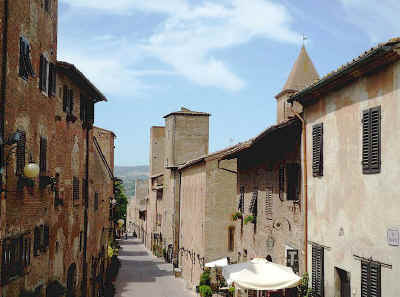
La Via Boccaccio
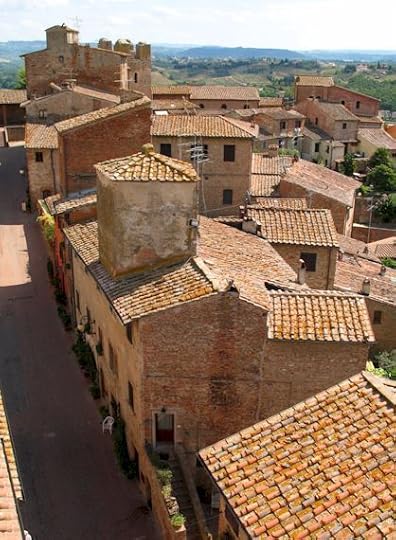
View from Casa Boccaccio
Book Portrait wrote: "DL wrote: "Oh, I read that somewhere, how he ended up doing copying work. I should have posted it but I didn't think at the time. Give me some time to try to jar my memory. This isn't the origin..."
I want to move there... Which bio are you reading?
I want to move there... Which bio are you reading?
 ReemK10 (Paper Pills) wrote: "I've been trying to find Fifth Tale (I, 5) origin from the 1001 Nights. BP maybe you can help....
ReemK10 (Paper Pills) wrote: "I've been trying to find Fifth Tale (I, 5) origin from the 1001 Nights. BP maybe you can help....The Marchioness of Montferrat by a banquet of hens seasoned with wit checks the mad passion of the..."
I'm a little bit behind (personal stuff going on over the week-end) but I'll look into it once I've read the story. :)
 I started the book late so I'm trying to catch up. The first story was great, what a character Ser Ciappaletto was:) The intro reminded me of the horror I experienced while reading Camus' "The Plague."
I started the book late so I'm trying to catch up. The first story was great, what a character Ser Ciappaletto was:) The intro reminded me of the horror I experienced while reading Camus' "The Plague."
Rowena wrote: "And wow, beautiful pictures in this thread!"
Yes. We have our own private Illuminator.
Yes. We have our own private Illuminator.
I have just read that Swift's A Tale of a Tub (which I have not read yet) is based on the Tale 3, of the First day.
To keep in mind when I tackle Swift again.
To keep in mind when I tackle Swift again.
 Amelia wrote: "Hello all! I enjoyed the Author's Introduction and the First Story so far. I also appreciated reading the Translator's Introduction, despite it being a bit lengthy, reading the G. H. McWilliam tr..."
Amelia wrote: "Hello all! I enjoyed the Author's Introduction and the First Story so far. I also appreciated reading the Translator's Introduction, despite it being a bit lengthy, reading the G. H. McWilliam tr..."I'm so far behind it isn't funny, but I have a very, very old edition. Tooled, cover, no pulbication date or ISBN, which means pre 193?? (help me, Geneva experts) (though the first edition with this publisher came out in 1895,or thereabouts). Surely McWilliams would have read it.
This translator, Payne, footnotes the names as follows, basing his interpretation on the Greek--Pampinea-the eldest, wisest, the leader (which fits in with Prudence) from the Greek to inform, advise or admonish. Pamfilo (representing Boccacio) as "all-loving, or passionate lover. Filomena, from the Greek for nightingale, song-loving. Emilia, from the Greek for pleasing, engaging in manners and behaviour, cajoling. Lauretta, a learned lady, a corruption of laureata, laurel-crowned, Neifile "new" plus "I love", so curious and loving of new things. He cannot explain Elisa, though he supposes it may be related to Dido.
Filostrato, loving war. Dioneo, probably derived from one of the agnomina of Venua, and "intended to denote the amorous temperament of his personage, to which, indeed, the erotic character of most of the stories told by him bears sufficient witness."
I haven't finished reading the thread or read the McWilliams intro, so pls forgive if this is redundant or repetitious.
 Kalliope wrote: "In the Introduction I enjoyed reading about the women who would go to the house of the defunct... Recently I attended a lecture that talked about what in Spanish are called "plañideras", or the "pl..."
Kalliope wrote: "In the Introduction I enjoyed reading about the women who would go to the house of the defunct... Recently I attended a lecture that talked about what in Spanish are called "plañideras", or the "pl..."This reminds me of "keeners"(sp?) in Ireland, not so far back in time. Someone who lives there could tell me if this still happens. "Keeners" would attend the wakes of those without large families or many (if anyone) to weep for them, and weep, wail, carry on, etc. I'm not certain if there was recompense or not; it was something that my friends from the North told me.
Books mentioned in this topic
A Tale of a Tub (other topics)Boccace: Conteur et passeur de la Renaissance (other topics)
Boccaccio: A Critical Guide to the Complete Works (other topics)
Boccace: Conteur et passeur de la Renaissance (other topics)
The Merchant of Prato: Daily Life in a Medieval Italian City (other topics)
More...


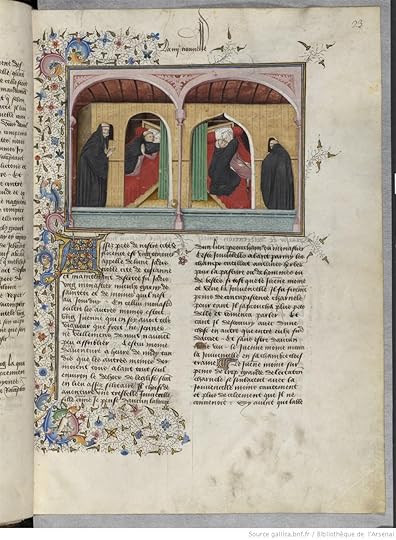
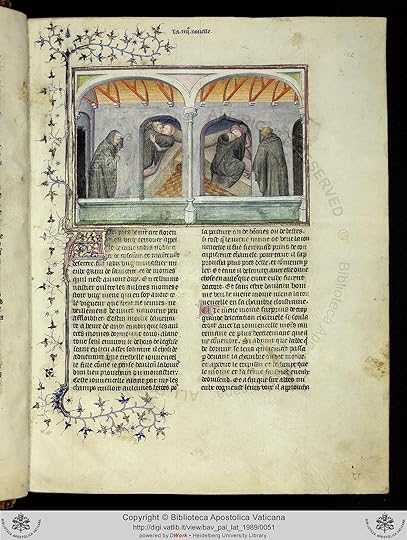
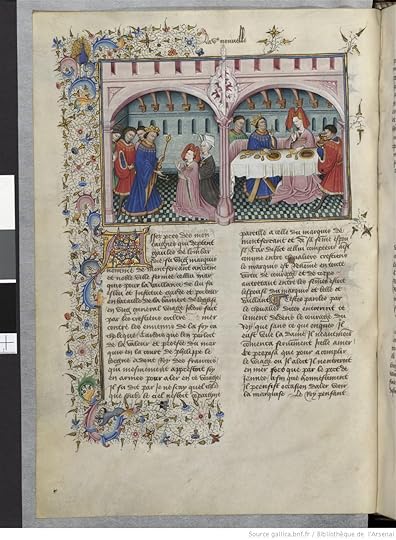






http://visualiseur.bnf.fr/ConsulterEl...
ms 63 - Saladin & Melchisédech of Alexandria
More (view spoiler)[
http://gallica.bnf.fr/ark:/12148/btv1...
ms 5070
http://digi.vatlib.it/diglitData/imag...
Pal lat 1989
(hide spoiler)]